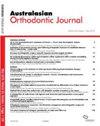The identification of possible reference planes on a CBCT scan taken with a small FOV—an observational analytical study
IF 0.9
4区 医学
Q4 DENTISTRY, ORAL SURGERY & MEDICINE
引用次数: 0
Abstract
Abstract Objectives Unlike a CBCT scan which has a large field of view (FOV), a scan with a small FOV may not involve the base of the skull. Therefore, routinely used reference planes may not be available to evaluate treatment outcome. The present study was undertaken to determine if the palatal plane and a molar occlusal plane may be used as reference planes to measure the change in the axial inclination of the maxillary central incisor and the maxillary first permanent molar towards the end of orthodontic treatment on a CBCT scan captured with a small FOV. Materials and methods A lateral cephalogram and a CBCT scan with a small FOV were taken for fifteen young adults prior to, and six months after, mini-implant supported, distal movement of the maxillary arch. CBCT multi-planar slices were sequentially viewed to obtain an image that contained the entire length of the maxillary central incisor and the maxillary first permanent molar in the tangential view. The axial inclination of the maxillary central incisor and the maxillary first permanent molar was measured from the palatal plane and the molar occlusal plane on both sides. The same parameters were evaluated on the lateral cephalogram using the palatal plane as a reference. An independent t test (p = 0.05) was conducted to compare the results. A Bland–Altman plot with linear regression was constructed to measure accuracy, method agreement and reliability. Results There was no statistically significant difference when a change in the axial inclination of the maxillary central incisor and the maxillary first permanent molar was measured using the two reference planes. The change in axial inclination of the maxillary central incisor and maxillary first permanent molar had a 95% confidence interval of -1.82 to 4.19 and -4.48 to 3.05 and a p-value of 0.425 and 0.701 on the right side, respectively, and a 95% confidence interval of -1.76 to 4.79 and -4.41 to 2.79 and p-value of 0.350 and 0.650 on the left side. Conclusions The molar occlusal plane and the palatal plane may be used as reference planes for measuring change in the axial inclination of the maxillary central incisor and the first permanent molar in a CBCT scan taken with a small FOV.在小视场角 CBCT 扫描中识别可能的参考平面--观察分析研究
摘要 目的 CBCT 扫描具有大视野(FOV),而小视野扫描则不同,它可能不涉及颅底。因此,常规使用的参考平面可能无法用于评估治疗效果。本研究旨在确定腭平面和臼齿咬合平面是否可用作参考平面,以测量在小视野捕获的 CBCT 扫描中,上颌中切牙和上颌第一恒磨牙在正畸治疗接近尾声时的轴向倾斜度变化。材料和方法 在上颌牙弓进行微型种植体支持的远端移动之前和之后六个月,为 15 名年轻成年人拍摄了侧位头影和小视野 CBCT 扫描图像。对 CBCT 多平面切片进行连续观察,以获得包含上颌中切牙和上颌第一恒磨牙整个长度的切面图像。从两侧腭面和臼齿咬合面测量上颌中切牙和上颌第一恒磨牙的轴向倾角。以腭面为参照物,在侧方头影上评估了相同的参数。比较结果采用独立 t 检验(p = 0.05)。通过线性回归绘制 Bland-Altman 图来测量准确性、方法一致性和可靠性。结果 使用两个参考平面测量上颌中切牙和上颌第一恒磨牙轴向倾角的变化,在统计学上没有显著差异。右侧上颌中切牙和上颌第一恒磨牙轴倾角变化的 95% 置信区间分别为-1.82 至 4.19 和 -4.48 至 3.05,P 值分别为 0.425 和 0.701;左侧上颌中切牙和上颌第一恒磨牙轴倾角变化的 95% 置信区间分别为-1.76 至 4.79 和 -4.41 至 2.79,P 值分别为 0.350 和 0.650。结论 磨牙咬合平面和腭平面可作为参考平面,用于测量小视野 CBCT 扫描中上颌中切牙和第一恒磨牙轴向倾斜度的变化。
本文章由计算机程序翻译,如有差异,请以英文原文为准。
求助全文
约1分钟内获得全文
求助全文
来源期刊

Australasian Orthodontic Journal
Dentistry-Orthodontics
CiteScore
0.80
自引率
25.00%
发文量
24
期刊介绍:
The Australasian Orthodontic Journal (AOJ) is the official scientific publication of the Australian Society of Orthodontists.
Previously titled the Australian Orthodontic Journal, the name of the publication was changed in 2017 to provide the region with additional representation because of a substantial increase in the number of submitted overseas'' manuscripts. The volume and issue numbers continue in sequence and only the ISSN numbers have been updated.
The AOJ publishes original research papers, clinical reports, book reviews, abstracts from other journals, and other material which is of interest to orthodontists and is in the interest of their continuing education. It is published twice a year in November and May.
The AOJ is indexed and abstracted by Science Citation Index Expanded (SciSearch) and Journal Citation Reports/Science Edition.
 求助内容:
求助内容: 应助结果提醒方式:
应助结果提醒方式:


